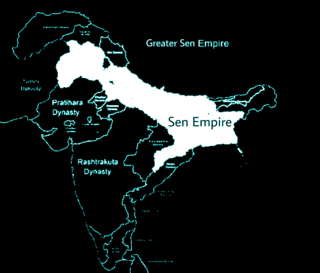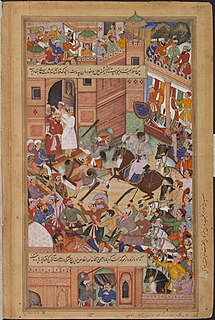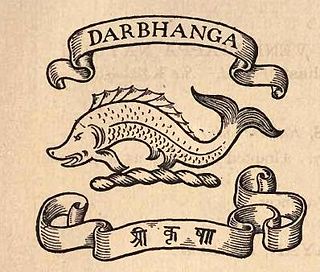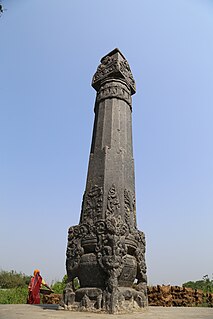Related Research Articles

Maithili is an Indo-Aryan language native to the Indian subcontinent, mainly spoken in India and Nepal. In India, it is spoken in the states of Bihar and Jharkhand and is one of the 22 recognised Indian languages. In Nepal, it is spoken in the eastern Terai and is the second most prevalent language of Nepal. Tirhuta was formerly the primary script for written Maithili. Less commonly, it was also written in the local variant of Kaithi. Today it is written in the Devanagari script.

The Dīn-i-Ilāhī, known during its time as Tawḥīd-i-Ilāhī or Divine Faith, was a syncretic religion or spiritual leadership program propounded by the Mughal emperor Akbar in 1582, intending to merge some of the elements of the religions of his empire, and thereby reconcile the differences that divided his subjects. The elements were primarily drawn from Islam, Hinduism, and Zoroastrianism, but some others were also taken from Christianity, Jainism, and Buddhism.

Vidyapati, also known by the sobriquet Maithil Kavi Kokil, was a Maithili and Sanskrit poet, composer, writer, courtier and royal priest. He was a devotee of Shiva, but also wrote love songs and devotional Vaishnava songs. He knew Sanskrit, Prakrit, Apabhramsha, and Maithili.

The Sena dynasty was a Hindu dynasty during the early medieval period on the Indian subcontinent, that ruled from Bengal through the 11th and 12th centuries. The empire at its peak covered much of the north-eastern region of the Indian subcontinent. The rulers of the Sena Dynasty traced their origin to the south Indian region of Karnataka.

The Akbarnama, which translates to Book of Akbar, the official chronicle of the reign of Akbar, the third Mughal Emperor, commissioned by Akbar himself and written by his court historian and biographer, Abu'l-Fazl ibn Mubarak. It was written in Persian, which is the literary language of the Mughals, and includes vivid and detailed descriptions of his life and times. It followed the Baburnama, the more personal memoir by his grandfather, Babur, founder of the dynasty. Like that, it was produced in the form of lavishly illustrated manuscripts.
Maithils, also known as Maithili people, are an Indo-Aryan ethno-linguistic group from the Indian subcontinent, who speak the Maithili language as their native language. They inhabit the Mithila region, which comprises Tirhut, Darbhanga, Kosi, Purnia, Munger, Bhagalpur and Santhal Pargana divisions of India and some adjoining districts of Nepal. The Maithil region forms an important part of Hinduism as it is said to be the birthplace of Sita, the wife of Ram and incarnation of Lakshmi.

Mithila, also known as Tirhut and Tirabhukti, is a geographical and cultural region of the Indian subcontinent bounded by the Mahananda River in the east, the Ganges in the south, the Gandaki River in the west and by the foothills of the Himalayas in the north. It comprises certain parts of Bihar and Jharkhand of India and adjoining districts of the eastern Terai of Nepal.
Mithila is a geographical and cultural region located in the Indian subcontinent. It comprises certain parts of Bihar and Jharkhand of India and adjoining districts of the eastern Terai of Nepal.The native language is known as Maithili and its speakers are referred to as Maithils. The majority of the Mithila region falls within modern-day India, more specifically in the state of Bihar. Mithila is bounded in the north by the Himalayas, and in the south, west and east by the Ganges, Gandaki and Mahananda respectively. It extends into the southeastern Terai of Nepal. This region was also called Tirabhukti, the ancient name of Tirhut.
Brajabuli is an artificial literary language popularized by the poet Vidyapati. His Brajabuli lyrics about the love which were turned out to be for Radha Krishna later on these are considered his best work. Other poets emulated his writing, and the language became established in the 16th century. Among the medieval Odia poets who wrote in Brajabuli are Ray Ramananda, Bhupati Pandita, Brundabati dasi, Narottama Das, Balarama Das, Jnanadas, and Gobinda das Kabiraj.
Lakshmana Sena, also called Lakshman Sen in modern vernaculars, was the ruler from the Sena dynasty of the Bengal region on the Indian subcontinent. His rule lasted for 28 years; and extended to much of the eastern regions of the Indian subcontinent, notably Bengal and Bihar regions. His reign ended with the invasion of Muhammad bin Bakhtiyar Khilji.
Vallalasena or Ballala Sena, also known as Ballal Sen in vernacular literature, was the second ruler of the Sena dynasty of Bengal region of the Indian subcontinent. He was the son and successor of Vijaya Sena, and ended the Pala Empire by defeating Govindapala.

The Bengali Calendar or Bangla Calendar, colloquially, is a luni-solar calendar used in the Bengal region of the Indian subcontinent. A revised version of the calendar is the national and official calendar in Bangladesh and an earlier version of the calendar is followed in the Indian states of West Bengal, Tripura and Assam. The New Year in the Bengali calendar is known as Pohela Boishakh.
Tirhuta Panchang is a calendar followed by the Maithili community of India and Nepal. This calendar is one of the many Hindu calendars. It is a tropical solar Hindu calendar in which the year begins on the first day of Baishakh month i.e. Mesh Sankranti. Every year, this day falls on 13/14 April of the Gregorian Calendar.
Surendra Jha 'Suman', also referred to as 'Suman Ji' or Acharya Surendra Jha 'Suman', was a Maithili poet, writer, publisher, editor and elected member of legislative assembly and parliament. He is also known for his role as publisher, editor, journalist, social and cultural reformer and promoter of Mithila culture. He authored about forty books in Maithili and was also the Editor of various publications and books in Maithili, Sanskrit and Hindi. He served the Governing Bodies of various literary and academic institutions in different capacities in his State. He was also the recipient of Sahitya Akademy Award in 1971 for Payaswini and in 1995 for Translation Rabindra Natakavali Vol. I. He was born in a village known as Ballipur in the Samastipur district of Bihar.
The Bangladeshi calendar is a civil calendar used in Bangladesh, alongside the Gregorian calendar and the Islamic calendar. With roots in the ancient calendars of the region, it is based on Tarikh-e-Ilahi, introduced by the Mughal Emperor Akbar on 10/11 March 1584. Amartya Sen states that only traces of Akbar's influence survive. The calendar is important for Bangladeshi agriculture, as well as festivals and traditional record keeping for revenue and taxation.
The Oiniwar dynasty, also known as the Sugauna dynasty, was a Maithil ruling dynasty of territories that form part of the Mithila region of the Indian subcontinent. They governed the area between 1325 and 1526, being preceded by the Karnat dynasty. Following the demise of the dynasty, there was a period of lawlessness in the region lasting around 30 years after which emerged the dynasty of the Raj Darbhanga.

The Karnat or Karnata Dynasty was a Maithil dynasty established in 1097 CE. The dynasty had two capitals which were Simraungadh in Bara District of Nepal and Darbhanga, Bihar which became the second capital during the reign of Gangadeva. The kingdom controlled the areas we today know as Tirhut or Mithila in Bihar state of India and Nepal. This region is bounded by the Mahananda River in the east, the Ganges in the south, the Gandaki River in the west and by the Himalayas in the north. Under the Karnats, Mithila enjoyed almost full sovereignty from 1097 until 1324.
The Varna Ratnakara, Maithili: वर्ण रत्नाकर,, literally "Ocean of description", is the oldest prose work of Maithili language, written in 1324 CE by the Maithil scholar, priest and poet Jyotirishwar Thakur. The author was a part of the court of King Harisimhadeva of the Karnat dynasty whose capitals were in both Simraungadh and Darbhanga.
Caṇḍeśvara Thakkura was a Maithili-language political theorist and general during the 14th century. He served as minister for peace and war and chief judge in the court of Harisimhadeva who was the last King of the Karnat dynasty of Mithila in modern-day northern Bihar of India and parts of Southern Nepal. His family had their origins in the village of Bisfi in Madhubani district of Bihar.

Ancient Mithila University was an ancient university and was famous for Nyaya Shastra and logical Sciences. It was gradually started from the philosophical conferences held by Janaka, the king of Mithila at his court. These philosophical conferences led to the formation of a seat of learning and this seat of learning converted into the university of Mithila. It was prominent seat of Brahmanical system of education.Mithila is the seat of Maithil Brahmins. From ancient times there were many notable Maithil Brahmins who gave different dimensions to the ancient Indian Philosophy. Nyaya Shastra, Tarka Shastra, Mimansa and Shankhya Shastra were mostly emerged in Mithila. Uddalaka Aruni discovered the theory of three elements of the life. Ashtavakra taught King Janaka the metaphysical nature of existence and the meaning of individual freedom. The philosophical conversation between Ashtavakra and Janaka is recorded as ancient philosophical texts known as Ashtavakra Gita or Ashtavakra Samhita. Similarly Yajnavalkya taught Brahman Vidya to the King Janaka.He is the author of Satapatha Brahman. He is also considered as the Father of Indian philosophy. Gargi Vachaknavi was a Brahmavadini. She composed several hymns in the Rig Veda that questioned the origin of all existence. She was honoured as one of the Navaratnas in the court of King Janaka of Mithila. She took part in the Shastrarth with Yajnavalkya, in which she asked some questions related to the foundation of the existence of the nature. Yajnavalkya answered all her questions. Maitreyi was another Brahmavadini who lived during the later Vedic period in ancient India. She is mentioned in the Brihadaranyaka Upanishad as one of two wives of the Vedic sage Yajnavalkya. She was Advaita philosopher. In the Rigveda about ten hymns are attributed to Maitreyi. She explores the Hindu concept of Atman in a dialogue contained in the Brihadaranyaka Upanishad. The dialogue, also called the Maitreyi-Yajnavalkya dialogue, states that love is driven by a person's soul, and it discusses the nature of Atman and Brahman and their unity, the core of Advaita philosophy. She is estimated to have lived around the 8th century BCE. Aksapada Gautama founded Nyaya Shastra. Mandana Mishra was a Hindu philosopher who wrote on the Mīmāṁsā and Advaita systems of thought. He was a follower of the Karma Mimamsa school of philosophy and a staunch defender of the holistic sphota doctrine of language. He was a contemporary of Adi Shankara. Maṇḍana Miśra is known to be a student of a mimamsa scholar Kumarila Bhatta, but who also wrote a work on Advaita, the Brahma-siddhi. He is best known as the author of the Brahmasiddhi. In the 9th to 10th century, Vācaspati Miśra was philosopher of Advaita Vedanta and wrote one non-commentary, Tattvabindu, or Drop of Truth, which focuses on Mīmāṃsā theories of sentence meaning. In the 14th century, Vidyapati emerged as Maithili and Sanskrit poet, composer, writer, courtier and royal priest in Mithila. He was a devotee of Shiva, but also wrote love songs and devotional Vaishnava songs. He knew Sanskrit, Prakrit, Apabhramsha, and Maithili.
References
- ↑ Sen, Sailendra (2013). A Textbook of Medieval Indian History. Primus Books. pp. 35–36. ISBN 978-9-38060-734-4.
- 1 2 3 4 5 F., Kielhorn (1890). "The Epoch of the Lakshmanasena Era". The Indian Antiquary, A Journal of Oriental Research. XIX.
- 1 2 Jha, Pankaj Kumar (2014). "Beyond the local and the universal: Exclusionary strategies of expansive literary cultures in fifteenth century Mithila". The Indian Economic & Social History Review. 51 (1): 1–40. doi:10.1177/0019464613515549. ISSN 0019-4646. S2CID 145373596.
- 1 2 3 Beveridge, H. (1888). "The Era of Lacchman Sen". Journal of the Asiatic Society of Bengal. LVII Part 1.
- ↑ Nanda R. Shrestha (2002). Nepal and Bangladesh: A Global Studies Handbook. ABC-CLIO. p. 200. ISBN 978-1-57607-285-1.
- ↑ Jha, Pankaj (2019-02-14), "Vidyapati and Mithila", A Political History of Literature, Oxford University Press, pp. 3–36, doi:10.1093/oso/9780199489558.003.0001, ISBN 978-0-19-948955-8 , retrieved 2021-03-07